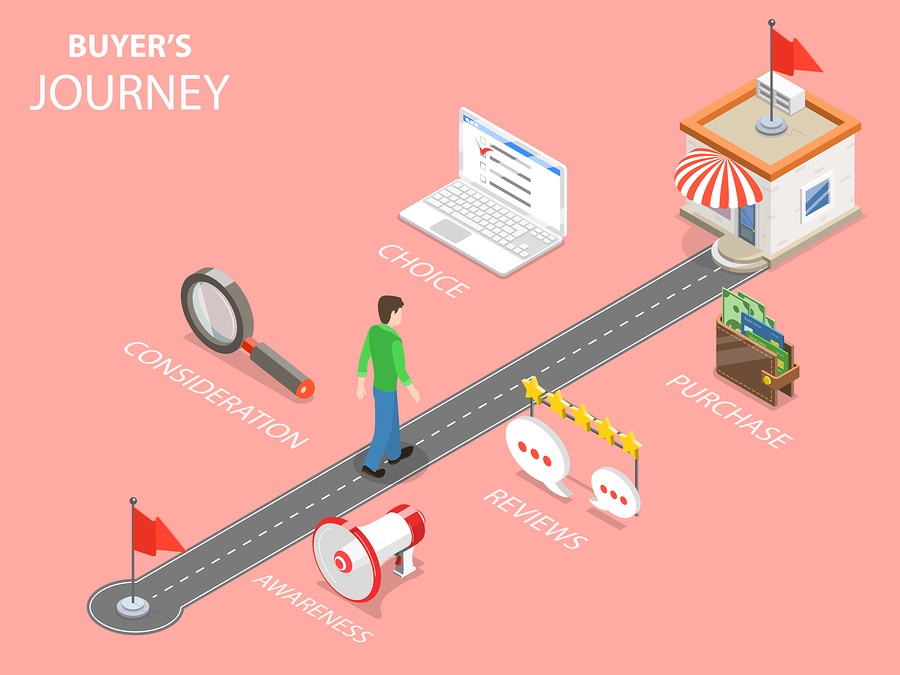
We talk a lot about the buyer’s journey on the TIMCo blog. Why? Because understanding the buyer’s journey is vital when it comes to creating the framework of your content strategy. The buyer’s journey should underpin every aspect of your content strategy, and as a small to medium sized organisation, it’s essential you understand the journey your customers take when researching and buying your product or service. In this article, we are going to be talking in-depth about the importance of understanding the buyer’s journey and how once you do, your marketing efforts will be more successful than ever before.
What is the Buyer’s Journey?
According to HubSpot, the buyer’s journey “is the process buyers go through to become aware of, evaluate, and purchase a new product or service”. The buyer’s journey follows a three-step process: awareness, consideration and decision. Let’s take a look at what each step entails.
The Awareness Stage
During the awareness stage, buyers become aware that they have a problem. At this early stage buyers aren’t actively searching for a solution they are understanding their challenge and responsive to content that will better educate them their goal, challenge or problem.
The Consideration Stage
The next stage of the buyer’s journey is the consideration stage. During this stage, buyers have clearly defined their goal or challenge and are now beginning to evaluate the different solutions that will solve their problem. At this point, buyers are evaluating different solution options, not brand or company specific solutions.
The Decision Stage
The final stage of the buyer’s journey is the decision stage. Once buyers have reached the decision stage, they have carried out enough research, have evaluated the different solutions to their problem and are finally read to choose a company to solve their challenge. At this stage buyers are evaluating brands and companies. At this stage buyers want to know more about your organisation and why they should choose you over a competitor. It may be quality of work, reviews, experience or price.
The Importance of Understanding the Buyer’s Journey
Now that you know the three stages of the buyer’s journey, it’s important you understand the why of buyers personas. Why they are important and how this knowledge impacts your marketing strategy and overall business objectives.
Independent research carried out by Gartner and Forrester suggest that by 2020, over 80% of the buying process will happen online and without any direct human interaction. What does this mean for your organisation? This highlights the importance of publishing content that is relevant to your customers early on in the buying process and at each stage. It will give you the competitive advantage of connecting with your customers from the very beginning and establishing trust and credibility during the buying process.
You may be wondering, if 80% of the buying process occurs without human interaction, how can your organisation connect with buyers during each stage? The answer is relatively simple, know the questions buyers might have during each stage, and publish helpful content your buyers can easily find online.
When you create relevant, valuable and insightful content that has been strategically geared towards each stage of the buyer’s journey, you are establishing yourself as a thought leader and a brand they can trust. Providing buyers with expert guidance is one of the best ways to build trust, which has an incredible influence on modern day buyers.
Content for Every Stage of the Buyer’s Journey
We now know it is important to create specific content geared towards each stage of the buyer’s journey. Yet what type of content is most effective for each stage? Let’s take a look.
Awareness Content
During this stage, buyers are heading to Google and asking questions that will help them better understand their problem. That’s why during the awareness stage, you want to be creating informative content that will educate people and help them better understand their challenge or need. Content at this stage could include:
- Blog articles
- eBooks
- Videos
- Webinars
Consideration Content
Once people have educated themselves on their problem, challenge or need they will begin to look for solutions. That’s why during the consideration stage, the type of content you want to be creating is content that will help buyers evaluate the different solutions available to them. Content at this stage could include:
- Comparison guides
- Buyers’ guides & checklists
- Blog articles
- Product feature videos
Decision Content
During the decision stage, buyers are looking at specific organisations they have narrowed down as potential vendors that will solve their problem. At this point, you should be publishing content that educates people on your expertise and past successes. This content will help to build confidence that you are the right organisation to remedy their need. Content during this stage could include:
- Case studies
- Client reviews and testimonies
- Awards
- Brands you’ve worked with
- Blog articles
- Webinars
If your organisation has provided helpful content at each stage of the buyer’s journey, you will increase your chances of generating more leads and closing them into customers. I hope you have found this article helpful in understanding why it is important you understand the buyer’s journey.


